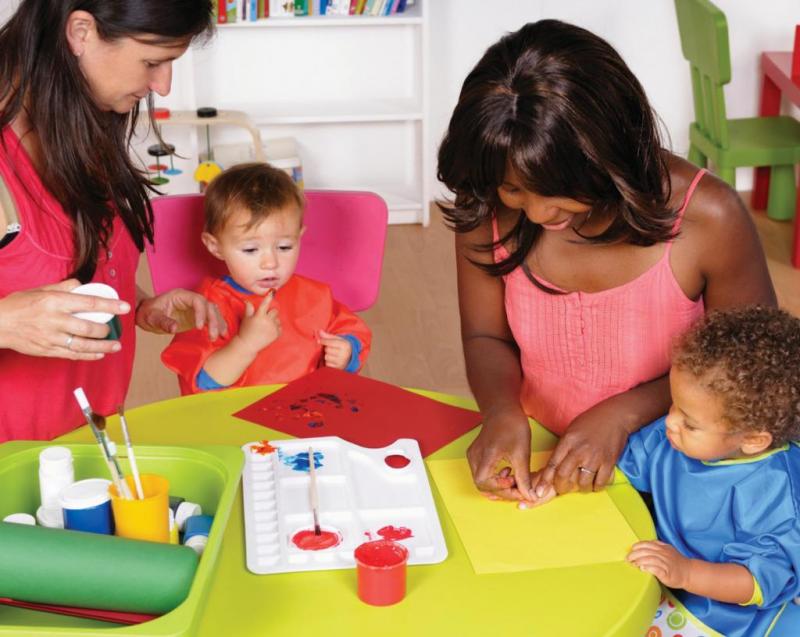Child Care Providers Struggle to Stay Safe
Low pay, high turnover, and now a pandemic that threatens to put them out of business.
Until May 21, Rafat Arain managed to keep her child care center in Milwaukee open as COVID-19 swept through the city.
Arain stayed open because she didn’t want school-aged kids to fall behind in their online schooling.
Her center, Crescent Learning Center, is Muslim faith focused and serves mainly refugee families — many of whose parents don’t speak English. Virtual learning has been difficult for the kids who come to her center.
“The parents could not help and … were getting very scared at what’s going to happen,” Arain said.

Rafat Arain with children she cares for at Crescent Learning Center in Milwaukee. Photo courtesy of Arain/WPR.
But then, two of her employees came down with COVID-19 and she had to close her doors.
Working with children, there’s always a risk, she said. It’s impossible to social distance with children, but when Arain plans to open up again on June 3, she will be even more cautious about safety measures.
“I’m 68 years of age, my husband has a heart problem. I don’t want to get sick. I don’t want anybody to get sick,” Arain said. “Now before opening up I want to make sure that I’m very, very, very strict on everything.”
“I’m going crazy thinking how I’m going to start it and not endanger everyone,” Arain said. “And I feel that we’ll all get it eventually, we’ll all get it.”
Arain’s concerns about keeping the children, staff and their families safe are echoed across the industry.
And the worry doesn’t stop at health concerns. Even before the coronavirus outbreak, financial strains were a reality for many child care centers that struggled with low pay, tight margins and high staff turnover.
Child care providers are in a difficult position. Essential workers with children rely on them to stay open, yet at the same time enrollment has plummeted — and child care centers’ income with it — as more parents are staying home because of job loss, or keeping their kids home for safety reasons.
Opening Again
Now as the state works on reopening, child care centers are trying to balance the threat of spreading COVID-19, while also making ends meet.
The lockdown was emotionally wearing on both the staff and the kids. Teachers are dealing with the looming possibility of layoffs — some have even cut back their hours, so others who need it more can work — while at the same time, they’re missing important milestones with the kids they have bonded with and had in their care.
For the kids, many are feeling the loss of friends who are no longer coming to child care, and they don’t understand why.
Still, Arain said she almost preferred the lockdown.
“I wasn’t so stressed out, to be honest, when we were locked down,” she said. “Now I’m more stressed out at opening up … to control a few people is easier.“
Arain and her staff will take temperature checks at the door, but she also knows that many of the parents risk losing their jobs if they take time off to care for sick kids, she said.
During the shutdown, Arain cared for about 30 school-aged children. Before the coronavirus, Arain and her staff of 19 had the capacity to care for 94 children between 6 weeks and 12 years old.
But with the state’s “Safer at Home” order no longer in effect, families are impatient to send their young children back to day care.
Arain is most concerned about the children under five, and she expects many of them will return.
“If you’re feeding a baby, how are you not going to hold the baby against yourself?” she asked. “My day care is like 7,500 square feet. We have a big space, we have open space, but I still cannot have people sit 6 feet apart.”
But she is determined to make it work, she said. “Now everyone has to do their role,” she continued. “We’re all in it together.”
While child care programs were encouraged to stay open at a reduced capacity during the state’s stay-at-home order, about 55 percent of group child care programs — serving more than 10 children — shut their doors, according to Ruth Schmidt, Wisconsin Early Childhood Association (WECA) executive director.
“It’s very hard for programs that were already operating on razor thin margins to figure out how to cover their costs at a time when we expect that there will be far fewer kids in care,” she said
Infant child care costs Wisconsin families more than $1,000 a month on average, according to the Economic Policy Institute. Yet early childhood teachers make an average of $10.33 an hourin the state, despite being more educated on average than the typical Wisconsin worker.
Access to quality, affordable child care isn’t easy to come by. Over half of Wisconsin kids live in a “child care desert,” which means for every three kids, there’s only one spot of licensed care, according to a 2018 report from the Center for American Progress.
Becky Ketarkus, co-owner of Little Chicks Learning Academy in Madison, said no one gets into the business for money, but she worries that if programs have to raise their costs to offset losses, the inequities in who can afford care will grow.
Her program went from caring for about 60 kids each day, down to just five in March through mid-April. While enrollment has been slowly inching up, it still remains at about 30 to 40 percent, she said.
Child care is often taken for granted, Ketarkus said, and there are few federal subsidies to bring the costs of child care down.
“What I don’t think people understand is that largely we are private providers,” she said. “And this is a business where we have to make payroll or pay rent … it’s a lot more fragile, I think, than people realize.”
As part of the federal coronavirus relief bill, $51 million has been set aside to assist child care centers in Wisconsin. The funding will be separated into three main areas: care for children of essential workers, incentive pay for early child care teachers and programs that had to temporarily shut their doors.
The funding is less than half of the $125 million Gov. Tony Evers proposed for the industry.
“It’s a really good thing,” Schmidt, of WECA, said. “It is definitely not enough.”
Both Ketarkus and Arain received federal Paycheck Protection Program (PPP) loans and have been able to hold onto their staff, so far. But navigating the loan has been confusing, and it only goes through the end of June — leaving them both wondering how their businesses will survive if they’re still operating at a dramatically reduced capacity.
“I’ve been doing nothing but thinking as to how I will jump into this fire,” Arain said.
‘Roller Coaster Of A Nightmare’
In her 17 years owning the center, Ketarkus said she’s never panicked so completely about her ability to meet everyone’s needs.
Offering employee benefits like health insurance is critical to Ketarkus in an industry where only 17 percent of teaching staff are eligible for and receive health insurance through their employer, according to a 2016 workforce study from WECA.
“That was one of my primary concerns, like, are we losing access to health insurance during the middle of a global pandemic?” she said. “That seemed like a primary factor in making sure that in some way or another, the doors stayed open.”
For six weeks, Little Chicks Learning Academy survived on savings — losing thousands of dollars a week — while they waited to receive their PPP loan, Ketarkus said.
“Those six weeks were a roller coaster of a nightmare, trying to figure out, can we even do this?” Ketarkus said. “That the center even had savings to fall back on is a very unique situation.”
But now that the initial scramble is over, the minute-to-minute panic has turned to long term uncertainty, she said.
Her center has parents who work in the restaurant industry and at hospitals, who are now facing pay cuts and unable to afford child care. And some families are choosing to keep their kids at home out of health concerns.
“I worry very much about the industry as a whole being able to survive this … that is keeping me up at night,” Ketarkus said. “How many of those (centers) are going to disappear? Are we going to be one of them? I can’t say … it’s one week at a time still with this virus.”
Listen to the WPR report here.
As Economy Reopens, Child Care Providers Grapple With How To Stay Safe, And Afloat was originally published by Wisconsin Public Radio.
More about the Coronavirus Pandemic
- Governors Tony Evers, JB Pritzker, Tim Walz, and Gretchen Whitmer Issue a Joint Statement Concerning Reports that Donald Trump Gave Russian Dictator Putin American COVID-19 Supplies - Gov. Tony Evers - Oct 11th, 2024
- MHD Release: Milwaukee Health Department Launches COVID-19 Wastewater Testing Dashboard - City of Milwaukee Health Department - Jan 23rd, 2024
- Milwaukee County Announces New Policies Related to COVID-19 Pandemic - David Crowley - May 9th, 2023
- DHS Details End of Emergency COVID-19 Response - Wisconsin Department of Health Services - Apr 26th, 2023
- Milwaukee Health Department Announces Upcoming Changes to COVID-19 Services - City of Milwaukee Health Department - Mar 17th, 2023
- Fitzgerald Applauds Passage of COVID-19 Origin Act - U.S. Rep. Scott Fitzgerald - Mar 10th, 2023
- DHS Expands Free COVID-19 Testing Program - Wisconsin Department of Health Services - Feb 10th, 2023
- MKE County: COVID-19 Hospitalizations Rising - Graham Kilmer - Jan 16th, 2023
- Not Enough Getting Bivalent Booster Shots, State Health Officials Warn - Gaby Vinick - Dec 26th, 2022
- Nearly All Wisconsinites Age 6 Months and Older Now Eligible for Updated COVID-19 Vaccine - Wisconsin Department of Health Services - Dec 15th, 2022
Read more about Coronavirus Pandemic here






















